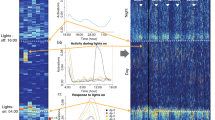Abstract
Activity and oxygen consumption studies on mice were performed in a very closely controlled environmental chamber. Some results are presented from these experiments in regard to the animals' possible dependence to age, sex, barometric pressure, light cycle and similar environmental parameters.
Zusammenfassung
Mobilität und Sauerstoffverbrauch von Mäusen wurden in einer Kammer mit genau kontrolliertem Klima untersucht. Einige experimentelle Resultate werden angegeben, in Bezug auf die möglichen Abhängigkeiten der Tiere von Alter, Geschlecht, barometrischem Druck, Lichtzyklus und ähnlichen Umgebungsfaktoren.
Resume
Des études sur la consommation d'oxygène et la vivacité chez la souris ont été faites dans un milieu dont les conditions étaient maintenues rigoureusement constantes. Certaines résultats expérimentaux sont présentés; ils concernent l'influence sur ces caractéristiques de paramètres tels que l'âge, le sexe, la pression barométrique, le cycle d'éclairement et d'autres paramètres de l'environnement.
Similar content being viewed by others
References
ALLEVA, J.J. and UMBERGER, E.J. (1966): Erratic timing of ovulation in hamsters exposed to constant light. Fed.Proc., 25: 251.
ASCHOFF, J. (1967): Adaption cycles: their significance for defining environmental hazards. Int.J.Biometeor., 11: 255–278.
BIANCA, W. (1964): Thermoregulatory response of the dehydrated ox to drinking cold and warm water in a warm environment. Res.Vet.Sci., 5: 75–80.
BIOLOGICAL HANDBOOKS (1964): Biology Data Book. Fed.Amer. Soc.Exp.Biol., Washington, D.C., p. 95.
BOGATOVA-NIKANOROVA, R.I. (1966): Diurnal rhythm of mitotic activity in certain tissues of young rats. Biul.Eksp.Biol.Med., 61: 110–112.
BROWN, F.A. and TERRACINI, E. (1959): Exogenous timing of rats spontaneous activity periods. Proc.Soc.exp.Biol. (N.Y.), 101: 457–460.
BROWN, F.A. (1960): Response to pervasive geophysical factors and the biological clock problem. Cold Spr.Harb.Symp.quant.Biol., 25: 57–71.
CHANCE, B., PYE, K. and HIGGINS, J. (1967): Waveform generation by enzymatic oscillators. IEE Spectrum, 4: 79.
CIVEN, M., ULRICH, R., TRIMMER, B.M. and BROWN, C.B. (1967): Circadian rhythms of liver enzymes and their relationship to enzyme induction. Science, 157: 1563–1564.
DOSS, D. and OHNESARGE, F.K. (1966): Motilität und Körpertemperatur von Mäusen in verschiedenen Umgebungstemperaturen. Pfluegers Arch.ges.Physiol., 289: 91–97.
EAYRS, J.T. and WILLIAMS, E.D. (1966): Diet and strain of animals as factors regulating thyroid activity. J.Endocr., 34: 277–278.
EVANS, C.S. (1966): Physiological effects of social stress in wild rats. Neuroendocrinology, 1: 113–120.
FRENKEL, R. (1966): Reduced diphosphopyridine nucleatide oscillations in cell free extracts from beef heart. Arch.Biochem.Biophys., 115: 112–121.
GASTON, S. and MENAKER, M. (1967): Photoperiodic control of hamster testis. Science, 158: 925–928.
GEBER, W.F., ANDERSON, R.A. and VAN DYNE, B. (1966): Physiologic responses of the albino rats to chronic noise stress. Arch.environm.Hlth., 12: 751–754.
GERRITZEN, F. (1966): Influence of light on human circadian rhythms. Aerospace Med., 37: 66–70.
GOFF, R.M.L. and FINGER, F.W. (1966): Activity rhythms and adiurnal lightdark control. Science, 154: 1346–1348.
GUYTON, A.C. (1947): Measurements of respiratory volumes of laboratory animals. Amer.J.Physiol., 150: 70–77.
HOLMQUEST, D.L., RETIENE, K. and LIPSCOMB, H.S. (1966): Circadian rhythms in rats: effects of random lighting. Science, 152: 662–664.
KAVANAU, J.L. (1967): Behaviour of captive white-footed mice. Science, 155: 1623–1639.
LAGERSPETZ, K.Y. (1966): Temperature relations of O2 consumption and motor activity in newborn mice. Ann.Med.exp.Biol.fenn., 44: 71–73.
LEWIS, J.E., Jr., CURTIS, S.E. and GARWOOD, A.V. (1968): Relations between atmospheric pressure fluctuations and swine gestation length variations. Int.J.Biometeor., 12: 159–162.
MACFARLANE, W.V. (1964): Terrestrial animals in dry heat: ungulates. In: Adaption to the Environment. Handbook of Physiology, Section 4. D.B. Dill (ed.), Williams and Wilkins, Baltimore, 509–539.
MALHOTRA, M.S. (1955): Environmental comfort zone in warm and humid atmosphere. J.Sci.Ind.Res. (India), 14 A, 469.
MENAKER, M. and ESKIN, A. (1966): Entrainment of circadian rhythms sound in Passer Domesticus. Science, 154: 1579–1581.
MENZEL, W. (1962): Menschliche Tag und Nacht Rhythmik und Schichtarbeit. Benno Schwabe Verlag, Basel, pp. 189.
MILLER, W.L. (1966): Respiratory quotient of albino rats, seasonal variations. Fed.Proc., 25: 719.
MOOS, W.S., CLARK, R.K. and KROWN, F. (1965): A precision controlled environmental chamber for the study of the effects of electric fields on biological objects. Int.J.Biometeor., 9: 117–126.
MORRISON, P.R. (1948): Oxygen consumption in several mammals under basal conditions. J.cell.comp.Physiol., 31: 69–96.
MÜLLER-BEISSENHIRTZ, P. and OHNESORGE, F.K. (1966): O2 Verbrauch von Mäusen in verschiedenen Umgebungstemperaturen. Pflueger Arch.ges.Physiol., 289: 98–108.
QUAY, W.B. (1965): Regional and circadian differences in cerebral cordical serotonin concentrations. Life Sci., 4: 379–384.
REITER, R.J., HESTER, R.J. and HASSETT, C.C. (1966): Thyroidal-pinealgonadal interrelationships in dark exposed female hamsters. Fed.Proc., 25: 252.
ROBINSON, S., TURRELLI, E.S. and GERKING, S.D. (1945): Physiologically equivalent conditions of air temperature and humidity. Amer.J.Physiol., 143: 21–32.
SPROTT, R.L. (1967): Barometric pressure fluctuations: effects on the activity of laboratory mice. Science, 157: 1206–1207.
TAYLOR, P.M. (1960): Oxygen consumption in new born rats. J.Physiol. (Lond.), 154: 153–168.
TROMP, S.W. (1968): Survey of recent advances in electro-biometeorology. Reports Biometeorol. Research Center, Leiden, No. 10, 1–15 (June 22).
WELCH, A.S. (1968): Isolation, ractivity and aggression: possible involvements of brain catechal- and indoleamines. Amer.Ass.Adv.Sci. Symposium, Physiology of Fighting and Defect, 28 Dec. 1968, Dallas, Texas.
WILLIAMS, M.W. (1966): O2 consumption of preweanling and weanling mice. Life Sci., 5: 541–543.
WILLIAMS, M.W., WILLIAMS, C.S. and DE WITT, G.R. (1966): Activity, weight and O2 consumption of hyperthyroid mice bearing sarcoma 180. Life Sci., 5: 545–549.
Author information
Authors and Affiliations
Additional information
This work was performed in part in the Department of Radiology at the University of Illinois, College of Medicine, Chicago, Illinois.
Rights and permissions
About this article
Cite this article
Moos, W.S., Clark, R.K., Le Van, H. et al. Behavior and physiology of mice in a closely controlled environment. Int J Biometeorol 14, 133–154 (1970). https://doi.org/10.1007/BF01440959
Received:
Issue Date:
DOI: https://doi.org/10.1007/BF01440959




